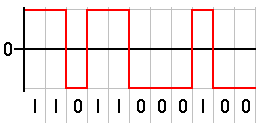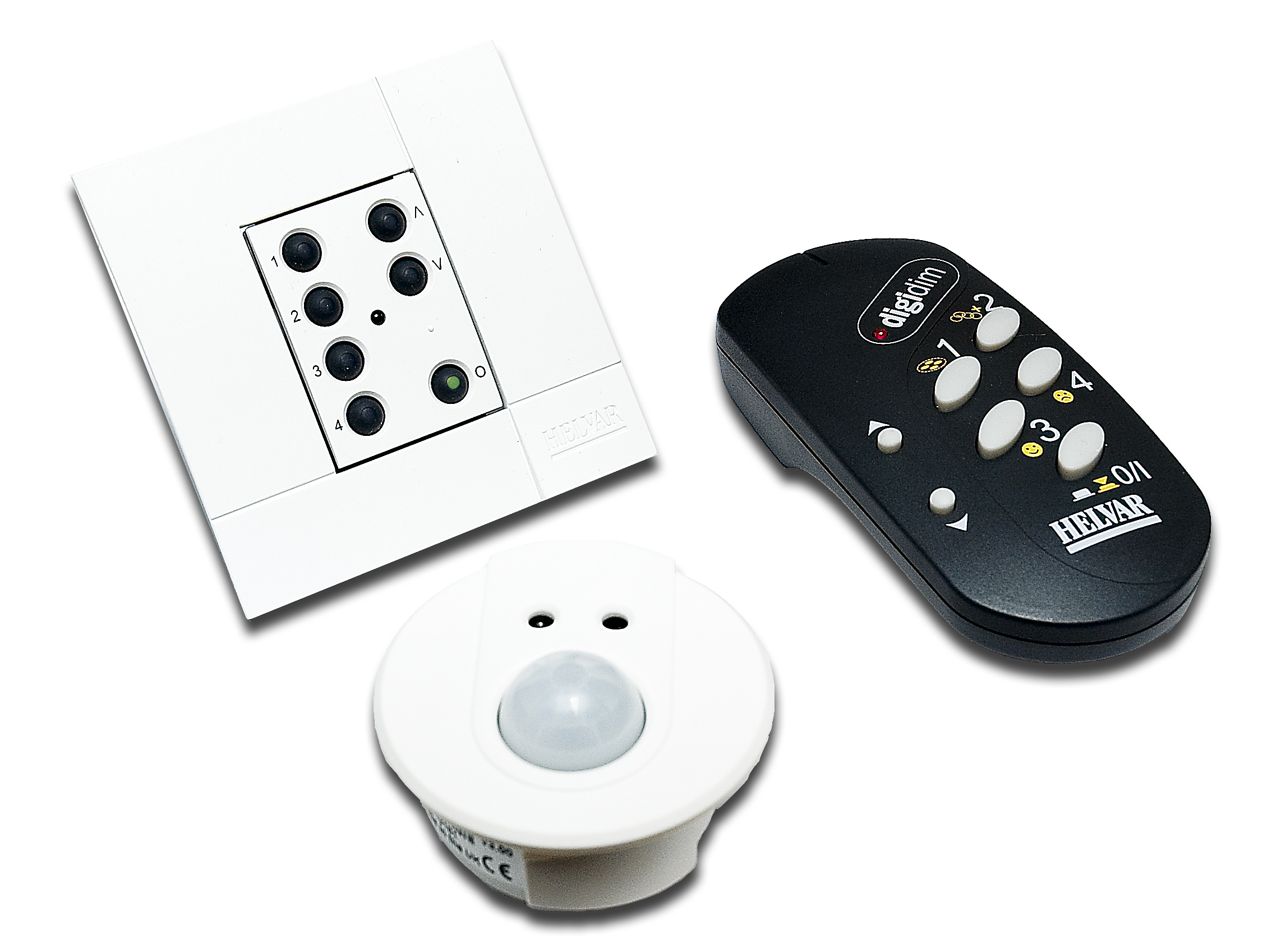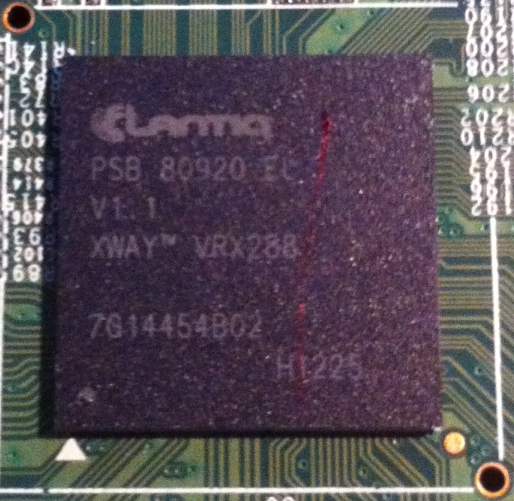|
Differential Manchester Encoding
Differential Manchester encoding (DM) is a line code in digital frequency modulation in which data and clock signals are combined to form a single two-level self- synchronizing data stream. Each data bit is encoded by a presence or absence of signal level transition in the middle of the bit period, followed by the mandatory level transition at the beginning. The code is insensitive to an inversion of polarity. In various specific applications, this method is also called by various other names, including biphase mark code (CC), F2F (frequency/double frequency), Aiken biphase, and conditioned diphase. Definition Differential Manchester encoding is a differential encoding technology, using the presence or absence of transitions to indicate logical value. An improvement to Manchester coding which is a special case of binary phase-shift keying, it is not necessary to know the initial polarity of the transmitted message signal, because the information is not represented by the ab ... [...More Info...] [...Related Items...] OR: [Wikipedia] [Google] [Baidu] |
|
 |
Line Code
In telecommunications, a line code is a pattern of voltage, current, or photons used to represent digital data transmission (telecommunications), transmitted down a communication channel or written to a storage medium. This repertoire of signals is usually called a constrained code in data storage systems. Some signals are more prone to error than others as the physics of the communication channel or storage medium constrains the repertoire of signals that can be used reliably. Common line encodings are Unipolar encoding, unipolar, Polar encoding, polar, Bipolar encoding, bipolar, and Manchester code. Transmission and storage After line coding, the signal is put through a physical communication channel, either a transmission medium or data storage medium.Karl Paulsen"Coding for Magnetic Storage Mediums".2007. The most common physical channels are: * the line-coded signal can directly be put on a transmission line, in the form of variations of the voltage or current (often us ... [...More Info...] [...Related Items...] OR: [Wikipedia] [Google] [Baidu] |
|
DC Bias
In signal processing, when describing a periodic function in the time domain, the DC bias, DC component, DC offset, or DC coefficient is the mean value of the waveform. A waveform with zero mean or no DC bias is known as a ''DC balanced'' or ''DC free'' waveform. Origin The term originates in electronics, where ''DC'' refers to a direct current voltage. In contrast, various other non-DC frequencies are analogous to superimposed alternating current (AC) voltages or currents, hence called AC component or AC coefficients. Applications In the design of electronic amplifier circuits, every active device has biasing to set its ''operating point'', the steady state current and voltage on the device when no signal is applied. In bipolar transistor biasing, for example, a network of resistors is used to apply a small amount of DC to the base terminal of the transistor. The AC signal is applied at the same terminal and is amplified. The bias network is designed to preserve the applied AC ... [...More Info...] [...Related Items...] OR: [Wikipedia] [Google] [Baidu] |
|
|
McASP
A Multichannel Audio Serial Port (McASP) is a communication peripheral in digital signal processor ( DSP) and microcontroller unit ( MCU) components from Texas Instruments. An McASP functions as a general-purpose audio serial port optimized for the needs of multichannel audio applications. Depending on the implementation, an McASP may be useful for time-division multiplexed ( TDM) streaming, inter-integrated circuit sound (I2S) protocol, and intercomponent digital audio interface transmission (DIT). However, some implementations are limited to I2S.CC3200 Single Chip Wireless MCU Technical Reference Manual An McASP consists of transmit and receive sections that may operate synchronized, or completely independently with separate master clocks, bit clocks, and frame syncs, and using d ... [...More Info...] [...Related Items...] OR: [Wikipedia] [Google] [Baidu] |
|
|
Manchester Code
In telecommunications and data storage, Manchester code (also known as phase encoding, or PE) is a line code in which the encoding of each data bit is either low then high, or high then low, for equal time. It is a self-clocking signal with no DC component. Consequently, electrical connections using a Manchester code are easily galvanically isolated. Manchester code derives its name from its development at the University of Manchester, where the coding was used for storing data on the magnetic drums of the Manchester Mark 1 computer. Manchester code was widely used for magnetic recording on 1600 bpi computer tapes before the introduction of 6250 bpi tapes which used the more efficient group-coded recording. Manchester code was used in early Ethernet physical layer standards and is still used in consumer IR protocols, RFID and near-field communication. It was and still is used for uploading commands to the Voyager spacecraft. Features Manchester coding is a spec ... [...More Info...] [...Related Items...] OR: [Wikipedia] [Google] [Baidu] |
|
 |
Floppy Disk
A floppy disk or floppy diskette (casually referred to as a floppy, a diskette, or a disk) is a type of disk storage composed of a thin and flexible disk of a magnetic storage medium in a square or nearly square plastic enclosure lined with a fabric that removes dust particles from the spinning disk. The three most popular (and commercially available) floppy disks are the 8-inch, 5¼-inch, and 3½-inch floppy disks. Floppy disks store digital data which can be read and written when the disk is inserted into a floppy disk drive (FDD) connected to or inside a computer or other device. The first floppy disks, invented and made by IBM in 1971, had a disk diameter of . Subsequently, the 5¼-inch (133.35 mm) and then the 3½-inch (88.9 mm) became a ubiquitous form of data storage and transfer into the first years of the 21st century. 3½-inch floppy disks can still be used with an external USB floppy disk drive. USB drives for 5¼-inch, 8-inch, and other-size floppy disks are rare ... [...More Info...] [...Related Items...] OR: [Wikipedia] [Google] [Baidu] |
|
ISO/IEC 7811
ISO/IEC 7811 ''Identification cards — Recording technique'' is a set of nine (7811-1 to 7811-9) standards describing the recording technique on identification cards. It comprises: "Part 1" '' Embossing'' "Part 2" ''Magnetic stripe — Low coercivity Coercivity, also called the magnetic coercivity, coercive field or coercive force, is a measure of the ability of a ferromagnetic material to withstand an external magnetic field without becoming Magnetization, demagnetized. Coercivity is usual ...'' "Part 3" ''Location of embossed characters on ID-1 cards''Part 3 is already withdrawn and revised by Part 1. "Part 4" ''Location of read-only magnetic tracks — Tracks 1 and 2''Part 4 is already withdrawn and revised by Part 2. ''Location of read-write magnetic track — Track 3''Part 5 is already withdrawn and revised by Part 2. ''Magnetic stripe — High coercivity'' ''Magnetic stripe — High coercivity, high density''Allows capacity 10 times that of a card conforming to Par ... [...More Info...] [...Related Items...] OR: [Wikipedia] [Google] [Baidu] |
|
|
Magnetic Stripe
The term digital card can refer to a physical item, such as a memory card on a camera, or, increasingly since 2017, to the digital content hosted as a virtual card or cloud card, as a digital virtual representation of a physical card. They share a common purpose: identity management, credit card, debit card or driver's license. A non-physical digital card, unlike a #Magnetic stripe card, magnetic stripe card, can Emulator, emulate (imitate) any kind of card. A smartphone or smartwatch can store content from the card issuer; discount offers and news updates can be transmitted wirelessly, via Internet. These virtual cards are used in very high volumes by the mass transit sector, replacing paper-based tickets and the earlier magnetic strip cards. History Magnetic recording on steel tape and wire was invented by Valdemar Poulsen in Denmark around 1900 for recording audio. In the 1950s, magnetic recording of digital computer data on plastic tape coated with iron oxide was invente ... [...More Info...] [...Related Items...] OR: [Wikipedia] [Google] [Baidu] |
|
 |
Digital Addressable Lighting Interface
Digital Addressable Lighting Interface (DALI) is a trademark for network-based products that control lighting. The underlying technology was established by a consortium of lighting equipment manufacturers as a successor for 1-10 V/ lighting control systems, and as an open standard alternative to several proprietary protocols. The DALI, DALI-2 and D4i trademarks are owned by the lighting industry alliance, DiiADigital Illumination Interface Alliance. DALI is specified by a series of technical standards in IEC 62386. Standards conformance ensures that equipment from different manufacturers will interoperate. The DALI trademark is allowed on devices that comply with the DiiA testing and certification requirements, and are listed as either registered (DALI version-1) or certifiedDALI-2 on the DiiA website - an extension of DALI-2 - was added by DiiA in November 2019. Members of the AG DALI were allowed to use the DALI trademark until the DALI working party was dissolved on 30 M ... [...More Info...] [...Related Items...] OR: [Wikipedia] [Google] [Baidu] |
 |
XDSL
Digital subscriber line (DSL; originally digital subscriber loop) is a family of technologies that are used to transmit digital data over telephone lines. In telecommunications marketing, the term DSL is widely understood to mean asymmetric digital subscriber line (ADSL), the most commonly installed DSL technology, for Internet access. In ADSL, the data throughput in the upstream direction (the direction to the service provider) is lower, hence the designation of ''asymmetric'' service. In symmetric digital subscriber line (SDSL) services, the downstream and upstream data rates are equal. DSL service can be delivered simultaneously with wired telephone service on the same telephone line since DSL uses higher frequency bands for data transmission. On the customer premises, a DSL filter is installed on each telephone to prevent undesirable interaction between DSL and telephone service. The bit rate of consumer ADSL services typically ranges from up to , while the later VDSL+ ... [...More Info...] [...Related Items...] OR: [Wikipedia] [Google] [Baidu] |
|
SMPTE Time Code
SMPTE timecode ( or ) is a set of cooperating standards to label individual frames of video or film with a timecode. The system is defined by the Society of Motion Picture and Television Engineers in the SMPTE 12M specification. SMPTE revised the standard in 2008, turning it into a two-part document: SMPTE 12M-1 and SMPTE 12M-2, including new explanations and clarifications. Timecodes are added to film, video or audio material, and have also been adapted to synchronize music and theatrical production. They provide a time reference for editing, synchronization and identification. Timecode is a form of media metadata. The invention of timecode made modern videotape editing possible and led eventually to the creation of non-linear editing systems. Basic concepts SMPTE timecode is presented in ''hour:minute:second:frame'' format and is typically represented in 32 bits using binary-coded decimal. There are also ''drop-frame'' and ''color framing'' flags and three extra ''bin ... [...More Info...] [...Related Items...] OR: [Wikipedia] [Google] [Baidu] |
|
 |
S/PDIF
S/PDIF (Sony/Philips Digital Interface) is a type of digital audio interface used in consumer audio equipment to output audio over relatively short distances. The signal is transmitted over either a coaxial cable using RCA connector, RCA or BNC connector, BNC connectors, or a fibre-optic cable using TOSLINK connectors. S/PDIF interconnects components in home theaters and other digital high-fidelity systems. S/PDIF is based on the AES3 interconnect Technical standard, standard. S/PDIF can carry two channels of uncompressed PCM audio or Audio compression (data), compressed 5.1 surround sound; it cannot support lossless surround formats that require greater bandwidth (computing), bandwidth. S/PDIF is a data link layer protocol as well as a set of physical layer specifications for carrying digital audio signals over either optical or electrical cable. The name stands for Sony/Philips Digital Interconnect Format but is also known as Sony/Philips Digital Interface. Sony and Philips ... [...More Info...] [...Related Items...] OR: [Wikipedia] [Google] [Baidu] |